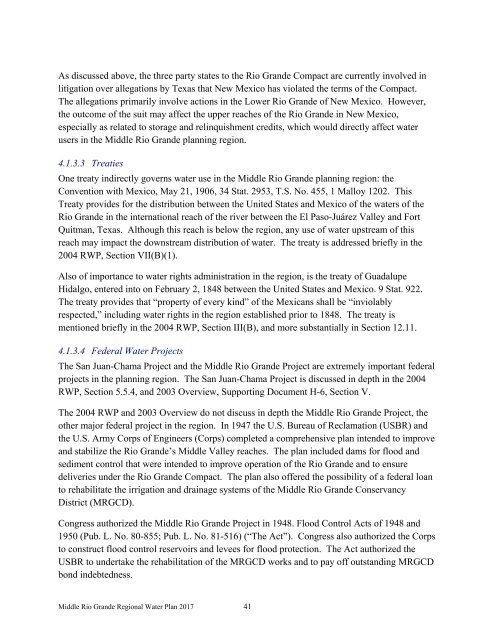Middle Rio Grande Regional Water Plan
2iUWd5b
2iUWd5b
Create successful ePaper yourself
Turn your PDF publications into a flip-book with our unique Google optimized e-Paper software.
As discussed above, the three party states to the <strong>Rio</strong> <strong>Grande</strong> Compact are currently involved in<br />
litigation over allegations by Texas that New Mexico has violated the terms of the Compact.<br />
The allegations primarily involve actions in the Lower <strong>Rio</strong> <strong>Grande</strong> of New Mexico. However,<br />
the outcome of the suit may affect the upper reaches of the <strong>Rio</strong> <strong>Grande</strong> in New Mexico,<br />
especially as related to storage and relinquishment credits, which would directly affect water<br />
users in the <strong>Middle</strong> <strong>Rio</strong> <strong>Grande</strong> planning region.<br />
4.1.3.3 Treaties<br />
One treaty indirectly governs water use in the <strong>Middle</strong> <strong>Rio</strong> <strong>Grande</strong> planning region: the<br />
Convention with Mexico, May 21, 1906, 34 Stat. 2953, T.S. No. 455, 1 Malloy 1202. This<br />
Treaty provides for the distribution between the United States and Mexico of the waters of the<br />
<strong>Rio</strong> <strong>Grande</strong> in the international reach of the river between the El Paso-Juárez Valley and Fort<br />
Quitman, Texas. Although this reach is below the region, any use of water upstream of this<br />
reach may impact the downstream distribution of water. The treaty is addressed briefly in the<br />
2004 RWP, Section VII(B)(1).<br />
Also of importance to water rights administration in the region, is the treaty of Guadalupe<br />
Hidalgo, entered into on February 2, 1848 between the United States and Mexico. 9 Stat. 922.<br />
The treaty provides that “property of every kind” of the Mexicans shall be “inviolably<br />
respected,” including water rights in the region established prior to 1848. The treaty is<br />
mentioned briefly in the 2004 RWP, Section III(B), and more substantially in Section 12.11.<br />
4.1.3.4 Federal <strong>Water</strong> Projects<br />
The San Juan-Chama Project and the <strong>Middle</strong> <strong>Rio</strong> <strong>Grande</strong> Project are extremely important federal<br />
projects in the planning region. The San Juan-Chama Project is discussed in depth in the 2004<br />
RWP, Section 5.5.4, and 2003 Overview, Supporting Document H-6, Section V.<br />
The 2004 RWP and 2003 Overview do not discuss in depth the <strong>Middle</strong> <strong>Rio</strong> <strong>Grande</strong> Project, the<br />
other major federal project in the region. In 1947 the U.S. Bureau of Reclamation (USBR) and<br />
the U.S. Army Corps of Engineers (Corps) completed a comprehensive plan intended to improve<br />
and stabilize the <strong>Rio</strong> <strong>Grande</strong>’s <strong>Middle</strong> Valley reaches. The plan included dams for flood and<br />
sediment control that were intended to improve operation of the <strong>Rio</strong> <strong>Grande</strong> and to ensure<br />
deliveries under the <strong>Rio</strong> <strong>Grande</strong> Compact. The plan also offered the possibility of a federal loan<br />
to rehabilitate the irrigation and drainage systems of the <strong>Middle</strong> <strong>Rio</strong> <strong>Grande</strong> Conservancy<br />
District (MRGCD).<br />
Congress authorized the <strong>Middle</strong> <strong>Rio</strong> <strong>Grande</strong> Project in 1948. Flood Control Acts of 1948 and<br />
1950 (Pub. L. No. 80-855; Pub. L. No. 81-516) (“The Act”). Congress also authorized the Corps<br />
to construct flood control reservoirs and levees for flood protection. The Act authorized the<br />
USBR to undertake the rehabilitation of the MRGCD works and to pay off outstanding MRGCD<br />
bond indebtedness.<br />
<strong>Middle</strong> <strong>Rio</strong> <strong>Grande</strong> <strong>Regional</strong> <strong>Water</strong> <strong>Plan</strong> 2017 41


